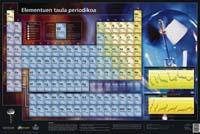Updated periodic table
2006/02/01 Lasa Iglesias, Aitziber - STEAM Hezkuntza arloko arduraduna Iturria: Elhuyar aldizkaria

The Elhuyar Foundation has published a new periodic table in two formats: the mural and the hand box. 16 data of each element, some graphically and others represented with numerical data: symbol, name, atomic number, atomic weight, electronic configuration, density, atomic radio, covalent and ionic, melting and boiling temperatures, first ionization energy, electronegativity, electronic affinity, metallic character and aggregation status. The hand box is printed on two sides, one with basic data and one with more technical data. It is therefore a table for both ESO and the university.
Since 1999 there have been many changes in the world of chemistry. The findings of different elements have been announced, some of which have been accepted by the IUPAC --international regulatory body.
This has motivated the need to publish an updated periodic table. The last table published by the Real Sociedad Bascongada de Amigos del País and the UPV-EHU reached element 110 and the previous one by Elhuyar only to 103. In the table we just published 118 elements appear, although it must be said that the safe data is up to item 111.
A little history
In 1868, chemist Julius Lothar Meyer discovered a periodic system for ordering the elements, but he did not publish it until 1870, late. In fact, in 1869, chemist Dimitri Mendeleiev proposed a periodic table for the classification of the elements. He ordered the elements by atomic floors by rows and columns (currently organized by atomic numbers), leaving gaps for elements that were not known then. Then some of the elements that should be in these places have been found and still others are being sought. The periodic table is therefore in continuous updating.




